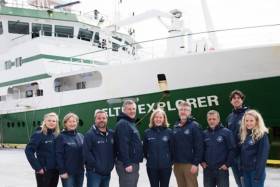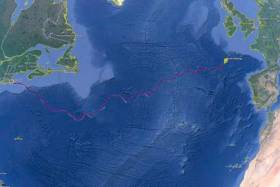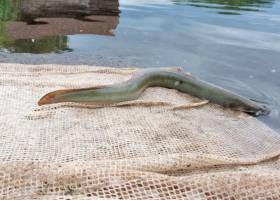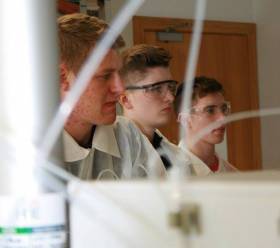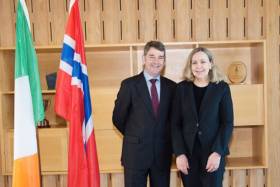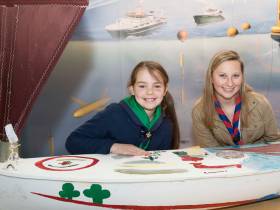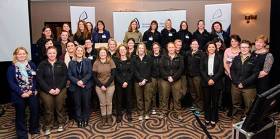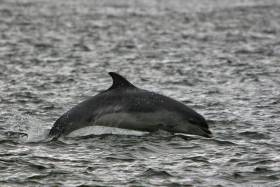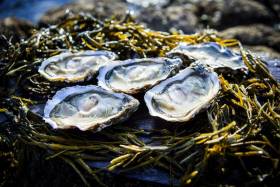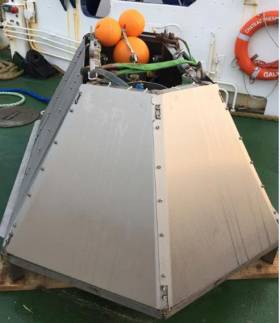Displaying items by tag: marine science
Six Countries Team Up To Take Temperature Of The Atlantic
#MarineScience - An international team of marine scientists from six countries are currently sailing on Ireland’s national research vessel RV Celtic Explorer on a transatlantic voyage to study the impact of climate change on the ocean.
Departing from St John’s in Newfoundland on Thursday 27 April — after launching the miniature yacht Lancer a few days previously — and due to arrive in Galway on 23 May, the Marine Institute-led team of experts are surveying a transect of the Atlantic Ocean last surveyed 20 years ago to investigate carbon dioxide levels in the ocean.
The survey is essential to understand and project how carbon dioxide emissions are accumulated in the oceans and the atmosphere, as well as its effects on the acidification of the ocean.
The survey is part of the Global Oceans Ship-Based Hydrographic Investigations Program (GO-SHIP), which carries out systematic and global surveys of select hydrographic sections, through an international consortium of 16 countries and laboratories.
This is the first GO-SHIP survey to involve this level of collaboration with scientists from ten leading universities and research institutes representing six countries joining the survey.
Marine Institute chief executive Dr Peter Heffernan said: “The Marine Institute is proud to lead this truly international collaboration. This GO-SHIP A02 survey is a very real example of the Galway Statement in action: working together to better understand and increase our knowledge of the Atlantic Ocean and its dynamic systems, and promoting the sustainable management of its resources.”
The Galway Statement, signed at the Marine Institute 24 May 2013, launched the Atlantic Ocean Research Alliance between the EU, Canada and the USA.
The survey is co-ordinated by the Marine Institute and NUI Galway with research partners in Dalhousie University and Fisheries and Oceans, Canada; University of Exeter, United Kingdom; GEOMAR, Germany; Woods Hole Oceanographic Institution and Columbia University, USA; and Aarhus University, Denmark.
“Ship-based surveys are still the only way to collect the best quality measurements of fundamental physical, chemical and biological properties known as Essential Ocean Variables,” said Dr Evin McGovern of the Marine Institute and principal investigator on the GO-SHIP A02 survey.
“Although technology has provided many new methods to collect ocean measurements, there’s really no substitute for going out on the ocean on a research vessel.
“We can use satellite technology to look at certain properties the ocean surface and can deploy autonomous argo floats to take some measurements to depths of 2000, but we need to carry out ocean surveys that can measure to get a complete picture of the chemistry of the ocean at different depths up to 5,000m.
“The transect we are surveying is a really dynamic area of the Atlantic for heat transport and carbon uptake and is hugely important to informing our understanding of our global climate and how the ocean regulates our climate,” added Dr McGovern.
“The Northwest Atlantic is one of the world’s largest sinks of carbon dioxide and despite progress in our understanding there’s still a huge lack of data as it relates to climate change’s impact on the ocean and what that means for the economy and society,” said Brad de Young, a professor of physics and physical oceanography at Memorial University, Newfoundland and an Ocean Frontier Institute researcher.
“Improving our scientific understanding and developing strategic and effective solutions for safe and sustainable ocean development requires sharing of expertise, international co-operation and exchange of data and best practices. And that’s what this voyage is all about,” adds Doug Wallace, Canada Excellence research chair at Dalhousie University.
Ocean Research Drone ‘Glider’ Recovered Off Baltimore
#MarineScience - A deep-ocean drone was recovered with the help of the Marine Institute off the coast of Baltimore in West Cork earlier this month.
The SILBO autonomous glider, deployed by Teledyne Webb Research USA from Falmouth, Massachusetts in April last year, was sent on a mission to cross the North Atlantic and gather data from the ocean.
SILBO is one of 16 gliders undertaking 128,000km of co-ordinated surveys following an ocean gyre around the five global ocean basins. as part of the Unesco-endorsed Challenger mission.
Gliders look like torpedoes but lack propellors and an engine, instead relying on a movable internal ballast and external moveable fins to move across the ocean. They contain large battery packs to power the movement of the fins and change the internal ballast, as well as to power the glider’s sensors for ocean monitoring.
"Gliders like SILBO are equipped with a variety of sensors that enable scientists to monitor the ocean temperature, salinity, currents and other ocean conditions as well as offering a picture of places in the ocean that traditional satellites and research vessels may not be able to,” explained Aodhan Fitzgerald, RV operations manager at the Marine Institute, which used its remote operated vehicle to help recover the drone off Baltimore on Thursday 9 March.
“By contributing real-time data to a global portal, deep-sea gliders enable marine scientists to mutually benefit by creating a better assessment and understanding of the ocean and evaluating the ocean environment.”
Gliders like SILBO have the ability to go where it is impractical to send people. They can travel major distances over long periods of time, moving both horizontally and vertically through the ocean, continually gathering data.
The drones are also programmed to surface at designated times throughout their mission, allowing them to transmit the data they have collected to shore while at the same time downloading new mission instructions.
This two-way communications ability allows gliders to continually gather information about the most important and diverse regions of our ocean basins.
The Marine Institute says it is currently developing its capacity to use such gliders as they are an important tool for marine scientists to study and map the dynamic features of the ocean.
"With the opportunity to learn more about deep-sea glider capabilities, SILBO will be used for a training session led by Teledyne Webb Research at the Marine Institute's facilities in Galway,” Fitzgerald added.
“This will involve Irish and international glider technicians learning how to overhaul the glider and prepare it for its next mission before it is re-deployed from Irish shores to complete further mission transects for this global initiative.”
Eel Fishermen Celebrated By IFI For Scientific Contributions
#Fishing - Local eel fishermen were celebrated recently at an information day hosted by Inland Fisheries Ireland in Athlone.
The fishermen, who are involved in IFI’s Scientific Eel Fisheries in different parts of the country, attended the event which aimed to provide an update on the progress made through these fisheries and to recognise the contribution of the fishermen to date.
In total, there are 11 fishermen involved in the initiative, with many experienced in fishing for eels over several years.
Since last year, they have provided support to IFI by fishing for eel in a conservation-focused manner with a view to gathering necessary data which will help protect the species into the future.
Their local expertise and historical knowledge around eels in their areaa has given invaluable support to IFI during the set up and delivery of the Scientific Eel Fishery.
IFI commenced the process of setting up a network of scientific fisheries for eel around Ireland in 2016. These scientific fisheries cover the different life stages — glass eel, elver, yellow and silver eel — and are distributed in key catchments around Ireland.
The purpose of the fisheries is to increase the knowledge around eels in Ireland ahead of the next EU review of this endangered species, and to inform the management of eel populations which are currently in decline.
Dr Cathal Gallagher, head of R&D at IFI, said: “This important partnership between eel fishermen and research has one shared objective: to improve our knowledge of the state of the eel populations and to ensure their conservation for future generations.
“Inland Fisheries Ireland appreciates the benefit of citizen science programmes such as this one which will preserve the heritage of eel fishing and at the same time deliver on the research requirements needed to report to the EU. I would like to recognise and thank all the fishermen involved for their support.”
Citizen science is growing in popularity and encompasses many different ways in which citizens who are non-scientists are involved in scientific research projects.
The involvement of fishermen in the Scientific Eel Fisheries plays an important role in respecting the tradition and heritage of eel fishing in Ireland. Many of the fishermen come from families where eel fishing has been practised across several generations with local expertise and knowledge passed down through the years.
#MarineScience - Over 20 Transition Year students participated in a wide range of activities at the Marine Institute as part of Engineering Week this past week from Monday 27 February to Friday 3 March.
For the third annual TY training week at the Marine Institute headquarters in Oranmore, the fourth-year pupils from Mayo, Galway, Kerry, Cork and Tralee increased their understanding of and interest in marine science, research engineering and technology careers.
Scientists and staff from the State agency responsible for marine research and innovation welcomed the opportunity to share their passion and insights across a wide range of areas in the marine science and maritime sectors.
Ireland's marine sector is a vibrant part of our national economy and the need for education in the marine sector at all levels is highlighted by Ireland's Integrated Marine Plan, Harnessing Our Ocean Wealth, according to Marine Institute chief executive Dr Peter Heffernan.
“Increasing the student's knowledge and engagement with marine careers in science, technology and innovation, as well as the sustainable development and management of our marine resource, is key to support Ireland's ocean economy, where highly qualified and skilled professionals are needed in the coming years,” he added.
The annual TY training course offers students an intensive week of shadowing scientists and staff learning about marine science, technology and engineering as well as a range of diverse supporting disciplines.
Promoting ocean literacy, the students took part in interactive experiments involving IT applications, marine environment and food safety, fisheries sciences, research vessel operations as well as advanced mapping, maritime development and communications.
The students found themselves working with hairdryers, balls and vinegar learning about data collection to how human industrial activities affect the increased levels of carbon dioxide in the ocean.
Interactive activities included dressing up in wet gear, forming sand sculptures of shipwrecks and working on group poster presentations provided learning opportunities that extended their skills and interests as well as raising their awareness about the ocean.
“With the training week fully booked out, we were delighted to see the increased levels of interest and understanding of the marine and the direct benefits of the communications and team building training that form an essential part of this rounded programme,” said Marine Institute HR manager Catherine Quigley-Johnston.
The programme aims to ensure a diverse and well-educated generation of marine scientists and researchers for the future, she added.
“The feedback from students confirms the need for industry and third level institutes, as well as State agencies to promote training and access for young people in marine and maritime careers.
“The training programme also highlights the effort and willingness of the Institute's staff to share their areas of expertise with the younger generations. This is what helps makes TY open days and training weeks so successful,” said Quigley-Johnston.
Marine Institute Hosts Norwegian Ambassador’s Galway Visit
#Research - A recent visit to the Marine Institute by the Norwegian Ambassador to Ireland Else Berit Eikeland was an opportunity to discuss marine research collaborations with a North Atlantic partner.
That’s according to Marine Institute chief executive Dr Peter Heffernan, who added: "The essential role of international cooperation in developing our knowledge of the Atlantic and North Atlantic Ocean and its dynamic systems is necessary, particularly in a time when we need to adapt to climate and environmental changes taking place around the world.
"Aligning our research efforts in areas such as fisheries ecosystem management; marine environment and food safety in aquaculture and shellfish; as well as oceanographic digital research, provides us with future partnerships that can benefit and improve ocean health and stewardship as well as promote the sustainable management of our ocean resources.”
The Marine Institute hosted the visit of Her Excellency Else Berit Eikeland, Ambassador of the Royal Norwegian Embassy to Galway, where she met executive management at its headquarters in Rinville, Oranmore last Thursday 23 February.
Transatlantic Friendship Over Unmanned US Sailboat
#Lancer - An American high school student this week made the trip across the Atlantic to meet the Galway schoolgirl who found her marine science project mini-yacht last year.
Kaitlyn Dow from Waterford High School in Connecticut met eight-year-old Méabh Ní Ghionnáin for the first time at the Marine Institute in Galway for the official handover of the unmanned Lancer sailboat, which is set to be relaunched from the RV Celtic Explorer in the Atlantic later this year.
The 1.5m boat provided by Educational Passages was used as part of Kaitlyn's year-long research project studying wind and currents in the ocean.
Fitted with a GPS transmitter, the boat was released in May 2016 by NOAA ship Neil Armstrong off the coast of Cape Cod and successfully crossed the Atlantic.
In September, Kaitlyn made an appeal to Afloat.ie readers to keep a look-out for Lancer as it was tracked as far as Galway Bay.
And when it was eventually washed up in Connemara on 20 September, Méabh was the first to find it after following its GSP signal to a spot near her home in Lettermore.
Marine Institute chief executive Dr Peter Heffernan congratulated Méabh and Kaitlyn on their endeavours, adding: "We are thrilled to be involved with the continued voyage of the Lancer sailboat where it will be launched from the research vessel RV Celtic Explorer during its up and coming transatlantic expedition in April.
"This story is a wonderful example of both science literacy and citizen engagement with the oceans – themes which are a priority for the Atlantic Ocean Research Alliance between Canada, the EU and USA.
“Seeing new friendships formed across the Atlantic at an early age highlights the value of international partnerships that are essential for sharing marine science.”
Dr Heffernan added: “With the Atlantic being the second largest ocean in the world, it is important to increase our awareness of the value, opportunities and societal benefits the ocean provides us.”
Michael O'Connor, Kaitlyn's science teacher from Waterford High School, also made the trip to Ireland wit her and her family.
"I am thrilled to see this project to the next stage bringing Méabh and Kaitlyn together,” he said. “Although this started as a science project, the social connections and the sea that binds them are just as important as the data collected.
"Kaitlyn learned to design a study from the ground up, figure out how to fund it, make the social and professional connections to further the project and foster an international dialog about the ocean.
“She has a love for sailing and turned that love into a science project with great social impact and a great story. She will carry that combined social service and love of the sea to the Coast Guard Academy next year for college.”
Lancer was repaired by Ciaran Oliver and James Rattigan from Port of Galway Sea Scouts, as previously reported on Afloat.ie.
The Sea Scouts recently visited the RV Celtic Explorer with Méabh and will also be attending a seashore safari with Galway Atlantaquaria and the Explorers Education Programme team later this month.
IFI Stands Up For Women & Girls In Science
#MarineScience – Women at Inland Fisheries Ireland who work across science projects are celebrating International Day of Women and Girls in Science today (11 February 2017).
International Day of Women and Girls in Science is a UN initiative which aims to help achieve full and equal access to and participation in science for women and girls.
Staff working in IFI carry out scientific fisheries research, monitoring and investigations which aim to manage, improve and protect the inland fisheries resource.
Find out more about International Day of Women and Girls in Science here.
NI Scientists Head Whale & Dolphin ‘Listening’ Project
#MarineScience - Scientists from Northern Ireland will lead a new project monitoring whale and dolphin sounds off the Scottish and Irish coasts, as BBC News reports.
The scheme led by the Agri-Food and Biosciences Institute (AFBI) will see a network of buoys deployed with devices to pick up cetacean chatter – as well as potentially harmful ocean sounds from sea traffic or industry.
"Displacement from noise is a very real effect and ... if it doesn't cause them to move will change their behaviours and, at the most acute levels, can cause physical and physiological damage to the animals,” says Dr Adam Mellor of the AFBI.
BBC News has more on the story HERE.
Marine Institute Recruiting Temporary Laboratory Analyst For Foodborne Viruses In Shellfish
#Jobs - The Marine Institute requires a laboratory analyst to provide support to a two-year research project investigating norovirus, hepatitis A virus, hepatitis E virus and sapovirus concentrations in oysters.
The work will primarily involve laboratory based detection of the viruses in oysters using existing and proposed molecular procedures. In addition, there may be some elements of field work including sampling and environmental monitoring.
This temporary specified-purpose contract of employment is funded under the FIRM programme and will run for a duration of up to two years. The successful candidate will be on probation for the first six months.
To apply, a CV and letter of application summarising experience and skill set applicable to the position should be emailed to [email protected] or posted to Human Resources at the Marine Institute, Rinville, Oranmore, Galway. All correspondence for this post should quote reference LA-FIRM-Jan 2017
All applications for this post should be received by the Marine Institute before noon next Tuesday 7 February. Late applications will not be accepted.
A detailed job description is available from the Marine Institute website HERE.
#MarineNotice - The latest Marine Notice from the Department of Transport, Tourism and Sport (DTTAS) advises that University College Dublin is running a scientific wave measurement campaign deploying a bed mounted ADCP at Inis Meáin in the Aran Islands s of yesterday (Saturday 28 January).
The ADCP, or acoustic Doppler current profiler, is deployed in a seabed-mounted frame at a depth of around 40 metres, with a ground line between the frame and a clump weight also rested on the seabed.
The purpose of the deployment is for measurement of waves and currents of the coast of Inis Meáin. This is a temporary deployment and it is proposed that the ADCP will be recovered before 15 May this year.
Co-ordinates and a map showing the deployment location are included in Marine Notice No 2 of 2017, a PDF of which is available to read or download HERE.


























